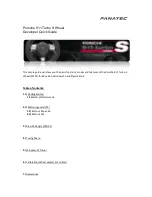
3
.
Accurate use of cooling liquid
The cooling system is not need maintenance normally.
When the car left the factory, the cooling system had been put with permanent cooling liquid. This kind of
cooling liquid is unnecessary to change.
The cooling liquid is mixed with half glycol and half water, its anti-freeze capacity is
-35°C and it has an excellent performance of antisepsis. Besides, the additive can prevent scaling, and
increase the boil point of the cooling liquid.
Based on the excellent performance above, this kind of cooling liquid should be used in the cooling system
perennially. Do not add pure water at any time (especially in summer or in some hot area) to avoid decreasing the
consistency of the cooling liquid. In order to make sure the normal function of the cooling liquid, the consistency
of the cooling liquid can not below 40%( volume proportion)
If it is necessary to improve the anti-freeze capacity of the cooling liquid, we can enhance the proportion of
the glycol properly, but the consistency of the cooling liquid can not beyond 60%(volume proportion). At that
time the engine can run normally under -48°C. Otherwise it will reduce the anti-freeze capacity and weaken the
cooling effect.
Extremely cold area(under -50°C), we should make out cold weather protection.
(1)
Check the height of the cooling liquid level. The tank of the cooling liquid is located in front clapboard.
The level of the cooling liquid should accord with the rules to fulfill the level when adding the fuel.
In order to check the cooling level accurately, we should closedown the engine and wait until it stops running
before checking. The tank of the cooling liquid is a translucently plastic pot, on which labels max and min, and it
is no need to open the tank to check the level.
When the engine is under cold condition, the cooling liquid level must be between the highest and the lowest
mark. Once it reaches to thermal state, the level may be higher than the highest mark.
Notice: if the cooling liquid appears exceptional loss, it may mean that the cooling system appears the
breakage of leaking, at this period of time, merely depending on adding cooling liquid cannot solve the problem
completely. So do not waste any time, come to the service station of the company right away to check the cooling
system.
(2)
Add the cooling liquid. Close down the engine, wait until it becomes cool and lay over the cover of the
cooling liquid tank with a cloth, turn it counter-clock wisely and wait the inside pressure fell down to
take out the cooling liquid tank, then add the cooling liquid.
Notice: when the engine is under thermal state, and when the cooling system is still under thermal and high
pressure state, do not open the cover of the cooling liquid tank in case of being scalded.
Under emergency, if we have to add pure water, we must add cooling additive afterwards as soon as possible
to make the consistency of the cooling liquid back to its normal state.
If the cooling liquid loses a lot, we have to add cooling liquid when the engine is under cold condition to
avoid the breakage of the engine.
When add the cooling liquid, do not add it beyond the highest mark of the cooling liquid tank! Because once
the engine reaches to the thermal state, the excessive cooling liquid will flow out through the limiting valve of the
tank cover under great pressure. After adding the cooling liquid, do screw down the cover tightly.
Notice: both of the cooling liquid and the cooling additive are poisonous! So the additive must be put into the
original container, and strictly forbid the children to touch it. If we have to release the cooling liquid in the system,
we should collect it properly and put it in a safe place. The ejective cooling should not be used again; we must
follow the rules of environment protection law to deal with the used cooling liquid.
4
.
Accurate use of brake liquid
(1)
Check the brake liquid level. The brake liquid tank is on the left of the front clapboard. The brake liquid
level must accord with the rules to meet the need of the brake system.










































